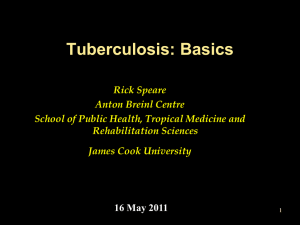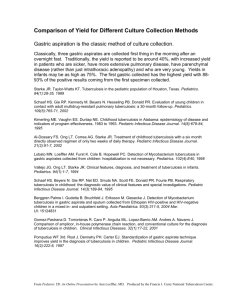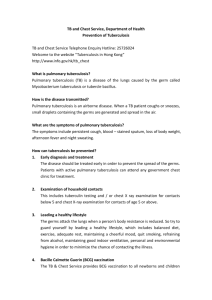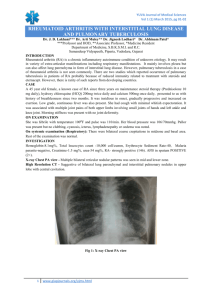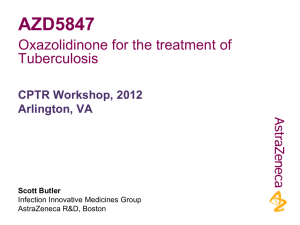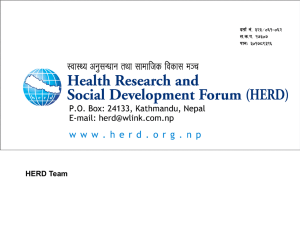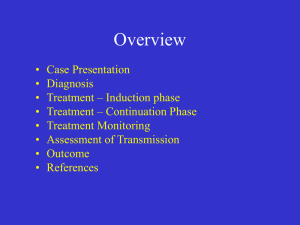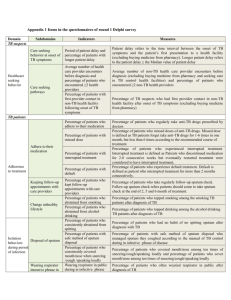In conclusion, diagnostic tests for pediatric TB and
advertisement
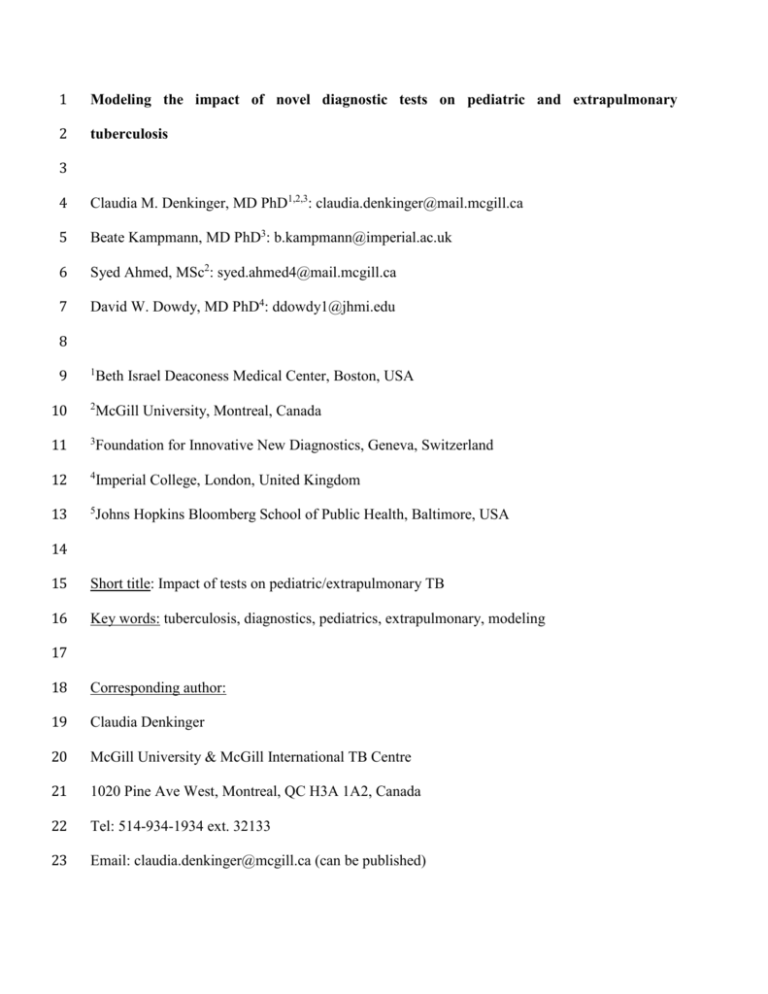
1 Modeling the impact of novel diagnostic tests on pediatric and extrapulmonary 2 tuberculosis 3 4 Claudia M. Denkinger, MD PhD1,2,3: claudia.denkinger@mail.mcgill.ca 5 Beate Kampmann, MD PhD3: b.kampmann@imperial.ac.uk 6 Syed Ahmed, MSc2: syed.ahmed4@mail.mcgill.ca 7 David W. Dowdy, MD PhD4: ddowdy1@jhmi.edu 8 9 1 Beth Israel Deaconess Medical Center, Boston, USA 10 2 McGill University, Montreal, Canada 11 3 Foundation for Innovative New Diagnostics, Geneva, Switzerland 12 4 Imperial College, London, United Kingdom 13 5 Johns Hopkins Bloomberg School of Public Health, Baltimore, USA 14 15 Short title: Impact of tests on pediatric/extrapulmonary TB 16 Key words: tuberculosis, diagnostics, pediatrics, extrapulmonary, modeling 17 18 Corresponding author: 19 Claudia Denkinger 20 McGill University & McGill International TB Centre 21 1020 Pine Ave West, Montreal, QC H3A 1A2, Canada 22 Tel: 514-934-1934 ext. 32133 23 Email: claudia.denkinger@mcgill.ca (can be published) 24 Abstract 25 Background: Extrapulmonary tuberculosis (EPTB) and most pediatric TB cannot be diagnosed 26 using sputum-based assays. The epidemiological impact of different strategies to diagnose EPTB 27 and pediatric TB is unclear. 28 29 Methods: We developed a dynamic epidemic model of TB in a hypothetical population with 30 epidemiological characteristics similar to India. We evaluated the impact of four alternative 31 diagnostic test platforms on adult EPTB and pediatric TB mortality over 10 years: (1) Nucleic 32 acid amplification test optimized for diagnosis of EPTB (“NAAT-EPTB”); (2) NAAT optimized 33 for pediatric TB (“NAAT-Peds”); (3) more deployable NAAT for sputum-based diagnosis of 34 adult pulmonary TB (“point-of-care (POC) sputum NAAT”); and (4) more deployable NAAT 35 capable of diagnosing all forms of TB using non-invasive, non-sputum specimens (“POC non- 36 sputum NAAT”). 37 38 Results: NAAT-EPTB lowered adult EPTB mortality by a projected 7.6% (95% uncertainty 39 range [UR]: 6.5-8.8%). NAAT-Peds lowered pediatric TB mortality by 6.8% (UR: 4.9-8.4%). 40 POC sputum NAAT, though only able to diagnose pulmonary TB, reduced projected pediatric 41 TB deaths by 13.3% (UR: 4.6-15.7%) and adult EPTB deaths by 8.4% (UR 2.0-9.3%) simply by 42 averting transmission of disease. POC non-sputum NAAT had the greatest effect, lowering 43 pediatric TB mortality by 34.7% (UR: 26.8-38.7), and adult EPTB mortality by 38.5% (UR: 44 30.7-41.2). The relative impact of a POC sputum NAAT (i.e., enhanced deployability) versus 45 NAAT-EPTB (i.e., enhanced ability to specifically diagnose TB-NSP) on adult EPTB mortality 46 depends most strongly on factors that influence transmission, with settings of higher 2 47 transmission (e.g., higher per-person transmission rate, lower diagnostic rate) favoring POC 48 sputum NAAT. 49 50 Conclusion: Although novel tests for pediatric TB and EPTB are likely to reduce TB mortality, 51 major reductions in pediatric and EPTB incidence and mortality also require better diagnostic 52 tests for adult pulmonary TB that reach a larger population. 53 54 55 56 57 58 59 60 61 62 63 64 65 66 67 68 69 3 70 Introduction 71 Improved diagnostic tests are needed to reduce the tremendous burden of morbidity and 72 mortality due to tuberculosis (TB), a disease that affects 8.6 million people and kills 1.3 million 73 every year [1]. In 2010, Xpert MTB/RIF (“Xpert”), a high-sensitivity rapid molecular test, was 74 released and soon thereafter endorsed by the World Health Organization (WHO) for the 75 diagnosis of adult pulmonary TB [2-4]. 76 77 While pulmonary TB accounts for the largest burden of disease and Xpert as well as most other 78 TB diagnostics are designed to use sputum as a biological specimen, at least 20% of all adults 79 (up to 30-40% in HIV patients) – and most children with TB – either cannot produce sufficient 80 sputum (“sputum-scarce”), do not have sufficient bacilli in their sputum to be detected, or have 81 extrapulmonary TB (EPTB) [5-8]. EPTB and pediatric TB result in significant morbidity and 82 mortality dependent on the organs affected (e.g., central nervous system) and due to the 83 difficulty in achieving a diagnosis [9, 10]. Therefore, further research on improving existing tests 84 and developing novel tests for pediatric TB and EPTB is necessary. 85 86 The most recent WHO guideline recommends Xpert for use in children and individuals with 87 certain subsets of EPTB [11, 12]. However, the evidence base for this recommendation is 88 considered to be very low-quality, and the accuracy of Xpert in its current version is insufficient 89 for subsets of EPTB (e.g. pleural TB and TB meningitis) [11, 12]. 90 91 In developing novel tests for pediatric and EPTB, one approach could be an “optimized” Xpert 92 or other nucleic acid amplification test (NAAT) capable of detecting M. tuberculosis with higher 4 93 sensitivity in specimens other than sputum (e.g. tissue) for example through improved sample 94 processing and DNA extraction. Another approach targeting the diagnosis of pulmonary TB in 95 children and others who cannot produce good sputum, might be an improved non-sputum based 96 assay (possibly optimized Xpert or other NAAT) using more easily accessible specimens (e.g. 97 nasopharyngeal samples) [11, 13]. 98 99 A third approach to improving the control of pediatric and EPTB is to develop more deployable 100 tests for adult pulmonary TB, reasoning that children and immunocompromised individuals are 101 at highest risk of developing active TB from recent transmission, and diagnosis and treatment 102 strategies capable of reducing TB transmission in a community might have important indirect 103 effects on pediatric and extrapulmonary TB [14]. The ideal assay, however, would be a test with 104 improved diagnosis for pulmonary TB, “sputum scarce” TB, and EPTB in adults and children 105 alike using clinical specimens other than sputum (e.g., blood or urine) on a deployable (able to 106 be rolled out at microscopy center level) and sensitive platform linked to rapid treatment 107 initiation [15]. 108 109 To evaluate the comparative effectiveness of such different diagnostic approaches for EPTB and 110 pediatric TB and evaluate them against a current baseline scenario with smear microscopy and 111 alternatively with Xpert for adult pulmonary TB at the district level health care, we constructed a 112 dynamic epidemic model of TB in a generalizable population, estimating ten-year EPTB and 113 childhood TB incidence and mortality if four hypothetical but emblematic tests for EPTB and 114 pediatric TB could be implemented. 115 5 116 Methods 117 Model structure 118 We built a compartmental model using ordinary differential equations to describe a mature 119 tuberculosis epidemic in a stable, homogeneously mixing population structured by age and HIV 120 status. Figure 1 describes the basic structure of the model; a more detailed description is found in 121 the supplement. Given that the hypothetical assays we evaluate should have impact across the 122 epidemiological contexts of greatest TB burden, we modeled a paradigmatic population with an 123 incidence of drug-susceptible (181/100,000 per year) and drug-resistant TB (2.1% MDR among 124 new cases) and an HIV prevalence similar to that of India (0.3%) [16]. We used data from World 125 Health Organization (WHO) notifications and other published literature to inform parameters in 126 our model (Table 1) [17, 18]. In order to optimize the benefit of tests for pediatric TB relative to 127 those for adult pulmonary TB, we made liberal assumptions about the percentage of TB that 128 occurs in children (taking into account the likely substantial underreporting of pediatric TB). 129 130 Our primary modeling aim was to assess the maximum potential impact of a test that has 131 enhanced capacity to diagnose clinical manifestations of TB that are not readily diagnosable with 132 sputum-based tests. Our primary outcomes were the projected incidence and mortality due to TB 133 overall, pediatric TB, and adult EPTB. 134 135 Pediatric and extrapulmonary TB are heterogeneous entities, including clinical sites as diverse as 136 lymph nodes, bone, and the central nervous system, each with different degrees of severity and 137 ability to be diagnosed by currently available means. As no model can fully account for such 138 clinical diversity, we represent these heterogeneous manifestations as a single entity, labeled “TB 6 139 with no sputum production” (TB-NSP), that reflects a weighted average of all TB clinical 140 manifestations that are not readily diagnosable by sputum-based assays. We presume that the 141 proportion of active TB consisting of TB-NSP is 85% in children (age 0-15) [6, 19], of which 142 about 70% is in fact pulmonary TB (with and without extrapulmonary components) that cannot 143 be diagnosed because a diagnostic sputum sample cannot be obtained, and the remaining 30% is 144 EPTB. In the adult population, we assume TB-NSP constitutes about 18% in HIV-uninfected 145 adults and 35% in HIV-infected adults (Table 1) [6, 20, 21]. 146 147 Model Calibration 148 We first established a baseline “year zero,” modeled as a scenario representative of the current 149 TB epidemic in India [18]. We initiated the model at steady state 65 years prior to year zero (e.g., 150 1950, if year zero corresponds to 2015), calibrating the TB transmission rate (number of 151 secondary infections per smear-positive person-year) to match India’s WHO-estimated TB 152 incidence (181 per 100, 000/year in 2011) [18]. To provide a realistic epidemic trajectory, we 153 reduced the overall TB transmission rate to a degree sufficient to generate a 2% per year decline 154 in TB incidence, the globally estimated average, five years before introducing the diagnostic 155 interventions [18]. 156 157 Diagnostic Algorithms 158 At baseline, we assumed a “standard” diagnostic approach for individuals suspected of having 159 adult pulmonary TB; this approach may consist of sputum examinations, ancillary diagnostic 160 tests (e.g. chest X-ray, antibiotic trials), and clinical judgment [22]. We calibrated the sensitivity 161 of this “standard approach” to a value (i.e. 80%) that provided a reasonable estimate of TB case 7 162 detection rate (model value 70% = Indian national estimate for smear-positive cases) [17]. 163 Diagnosis through this standard approach is assumed to occur at a given constant rate; in 164 calculating this rate, we assumed that the delay in diagnosing TB-NSP would be twice that for 165 adult pulmonary TB because of the difficulty in obtaining a sample from the site of infection 166 (e.g. pleural aspirate or gastric fluid) for diagnosis [23]. 167 168 In our analytic scenarios, we then enhanced this baseline diagnostic algorithm with platforms 169 designed to improve diagnosis of TB-NSP through different combinations of (a) optimized 170 detection of TB using clinical specimens other than sputum and/or (b) enhanced deployability of 171 the assay itself: 172 173 Xpert MTB/RIF for adult pulmonary TB 174 Starting in year zero, we augmented the “standard” diagnostic approach with Xpert for adult 175 pulmonary TB for adult pulmonary TB. We assumed that Xpert would increase the overall 176 sensitivity of the standard approach for the diagnosis of adult pulmonary TB – incorporating all 177 existing diagnostic tests, plus clinical judgment – from 80% to 95% (i.e., detecting 75% of TB 178 cases who would otherwise be missed with 98% specificity) [22, 24]. We assumed that given 179 Xpert’s current infrastructure requirements (e.g., constant power supply), it would be 180 implemented in district level health centers and therefore would reach 15%, 30% and 30% of 181 new, previously treated, and failure cases respectively (i.e. deployability limited to district level 182 health centers). The remainder of cases continued to be diagnosed with the standard approach. 183 184 Optimized diagnostic approaches 8 185 We compared the impact of Xpert for adult pulmonary TB to that of four hypothetical tests that 186 were designed to illustrate important test characteristics (e.g., components of a “target product 187 profile”) and tradeoffs between deployability and ability to diagnose TB-NSP (and may or may 188 not involve an Xpert like algorithm). We use the term “deployability” to denote the level of the 189 healthcare system at which a diagnostic test can be implemented, and thus the proportion of the 190 healthcare-seeking population that could reasonably be tested – assuming that tests implemented 191 at more peripheral levels (e.g., microscopy centers) could reach a wider population than those 192 implemented only in centralized laboratories. To maintain generalizability, we did not attempt to 193 model any specific test currently in development. The four hypothetical tests were: 194 195 (1) “NAAT Peds” – same accuracy (i.e. 95% sensitivity and 98% specificity), deployability and 196 ability to diagnose adult pulmonary TB as Xpert but capable of diagnosing, in addition, 70% of 197 all forms of TB-NSP with a respiratory component in children (e.g., using nasopharyngeal fluid 198 but not able to diagnose, for example, TB meningitis); 199 (2) “NAAT-EPTB” – deployability equal to Xpert (owing to the need for obtaining invasive 200 specimens such as cerebrospinal fluid or gastric fluid) but capable of diagnosing both TB-NSP 201 and pulmonary TB with the same accuracy as Xpert (i.e. 95% sensitivity and 98% specificity), 202 through use of non-respiratory samples; 203 (3) “POC sputum NAAT” – same sensitivity and specificity as Xpert for adult pulmonary TB, 204 only more portable and less dependent on existing infrastructure (i.e. deployable at microscopy 205 center level); modeled as reaching 50%, 80%, and 100% of new, previously treated, and failure 206 cases respectively; 9 207 (4) “POC non-sputum NAAT” – similar to POC sputum NAAT (same sensitivity and specificity 208 as Xpert) but using a more accessible clinical specimen (e.g., urine or finger-prick blood) and 209 thus capable of diagnosing both pulmonary TB and TB-NSP, with the same speed for both as it 210 does not require an invasive sample but without rifampin resistance detection [14, 15]. 211 212 Sensitivity analysis 213 We conducted one-way sensitivity analyses on all model parameters taking as the outcome the 214 difference in adult EPTB mortality comparing NAAT-EPTB (improved detection of TB-NSP 215 through access of non-pulmonary sites) to POC sputum NAAT (improved detection through 216 higher deployability of a sputum-based test). The ranges of the parameters are based on the 217 available literature and possible advances in the near future, as outlined in Table E1. To estimate 218 variability associated with simultaneous changes in all parameters, we also conducted a 219 probabilistic uncertainty analysis using Latin Hypercube Sampling (additional detail in the 220 supplement). 221 222 Results 223 Impact on TB incidence 224 In the absence of any improvement in TB diagnosis, we projected, in year ten, 44.8 TB cases and 225 9.4 deaths per 100,000 in children and 89.5 cases and 22.8 deaths in adults (Table 2). If Xpert for 226 adult pulmonary TB was scaled up in year zero for 15% of new and 30% of previously treated 227 cases, TB incidence fell from this baseline by 5.0% in children (95% uncertainty range [UR]: 228 1.6-6.1%) and 4.0% in adults (UR 1.0-4.5%). Implementation of Xpert for adult pulmonary TB 10 229 after 10 years did not change the proportion of TB that was TB-NSP (30% in adults, 78% in 230 children). 231 232 Replacement of Xpert for adult pulmonary TB with POC sputum NAAT (i.e., a more deployable 233 but equally accurate sputum-based test) resulted in more TB being diagnosed and treated, thus 234 reducing pediatric TB incidence by 13.8% (UR 4.6-16.3%) and adult TB incidence by 11.1% 235 (UR 2.7-11.9%). A similar test on non-sputum-based samples that could not detect rifampin 236 resistance (i.e., POC non-sputum NAAT) had nearly similar impact on incidence: 13.0% (UR 237 4.0-15.5%, from 44.8 to 39.0 cases per 100,000/year) reduction in children and 10.4% (UR 2.3- 238 11.4%; from 89.5 to 80.2 cases per 100,000/year) in adults (Figure 2A, Table 2). In contrast, 239 NAAT-EPTB and NAAT-Peds did not reduce TB incidence beyond the effect of Xpert for adult 240 pulmonary TB alone (Table 2), reflecting model assumptions that EPTB is not infectious and TB 241 in children is substantially less infectious than pulmonary TB in adults. NAAT-EPTB also had 242 only a small incremental effect on adult TB-NSP prevalence over Xpert alone (4.5% reduction). 243 244 Impact on TB mortality 245 After 10 years, Xpert for adult pulmonary TB reduced deaths by a projected 4.8% in children 246 (UR 1.6-5.9%) and 4.5% in adults (UR 1.6-5.6%) (Figure 2B, Table 2), closely mirroring 247 reductions in incidence. All diagnostic tests for TB-NSP had substantially greater impact on TB 248 mortality than on incidence. The addition of detection of TB-NSP in children with NAAT-Peds 249 and in adults with NAAT-EPTB enhanced mortality reductions to 6.8% (UR 4.9-8.4%) in 250 children and 5.9% (UR 3.9-7.3%) in adults, respectively. 251 11 252 NAAT-EPTB and POC sputum NAAT achieved similar reductions in adult EPTB mortality after 253 10 years (7.6% [UR 6.5-8.8%] and 8.4% [UR 2.0-9.3%], respectively), but through different 254 mechanisms: NAAT-EPTB resulted directly in better treatment of adult EPTB, whereas POC 255 sputum NAAT reduced TB transmission and thus the number of future cases of adult EPTB. 256 Since its mechanism was more direct, NAAT-EPTB achieved its effect on mortality more rapidly 257 (Figure 3A). However, since the majority of TB is adult pulmonary TB, POC sputum NAAT had 258 a much greater effect on overall adult TB mortality (12.2% reduction [UR 4.5-14.8%] compared 259 to 5.9% [UR 3.9-7.3%] with NAAT-EPTB). Similar to the NAAT-EPTB for adult EPTB 260 mortality, the NAAT-Peds outperformed POC sputum NAAT in early years, but POC sputum 261 NAAT led to greater reductions in TB mortality – and even pediatric-specific TB mortality – 262 over time: 13.3% [UR 4.6-15.7%] versus 6.8% [UR 4.9-8.4%] at ten years (Figure 3B). 263 264 POC non-sputum NAAT had the greatest impact on TB mortality, reducing pediatric TB 265 mortality by 34.7% (UR 26.8-38.7%; from 9.4 to 6.1 deaths per 100,000/year) and adult EPTB 266 mortality by 38.5% (UR 30.7-41.2; from 7.3 to 4.5 deaths per 100,000/year). 267 268 Sensitivity analysis 269 We focused our primary sensitivity analysis around the comparison of POC sputum NAAT (i.e., 270 enhanced deployability) versus NAAT-EPTB (i.e., enhanced ability to specifically diagnose TB- 271 NSP). The relative impact of these two tests on adult EPTB mortality depends most strongly on 272 factors that influence transmission, with settings of higher transmission (e.g., higher per-person 273 transmission rate, lower diagnostic rate) favoring POC sputum NAAT (Figure 4). Since the 274 sensitivity of the existing diagnostic standard is much higher for adult pulmonary TB than for 12 275 TB-NSP, the impact of POC sputum NAAT depends more strongly on the sensitivity of the 276 existing standard than does NAAT-EPTB. No one-way parameter variation across the ranges in 277 Table E1 changed the absolute difference in mortality by more than 1.2 cases per 100,000 per 278 year. Further sensitivity analyses, including a 3-way sensitivity analysis on the sensitivity of the 279 existing standard for PTB, the incremental sensitivity of the novel test and the diagnostic rate, 280 are reported in the supplement. 281 282 Discussion 283 This transmission model of a TB epidemic in a defined population suggests that novel assays 284 capable of diagnosing TB-NSP in addition to TB that is diagnosed through sputum examination 285 may generate important (3-8%) reductions in adult EPTB and childhood TB mortality by ten 286 years. However, greater impact on pediatric TB and EPTB mortality (10-15%) may be 287 achievable by deploying tests capable of detecting adult pulmonary TB more widely (i.e., by 288 reducing pediatric and extrapulmonary TB indirectly through reducing transmission). 289 Nevertheless, dramatic reductions in incidence and mortality are unlikely unless a novel test can 290 be developed that cannot only detect TB-NSP but do so using a deployable platform on clinical 291 specimens other than sputum (e.g., hypothetical urine or finger-prick blood assay). 292 293 The indirect effect of a more deployable Xpert-like sputum test on pediatric TB (i.e. POC 294 sputum NAAT) on children is particularly noteworthy. TB in children is acquired predominantly 295 from adults and very young children have a greater risk for progression to active disease [25]. 296 Thus, infection and disease in young children are a measure of TB transmission, and tests (e.g., 297 POC sputum NAAT) that add no direct benefit to the diagnosis of TB in these children may 13 298 counter intuitively still have their greatest effect among such young children, in whom nearly all 299 active TB results from recent transmission [26]. Comprehensive control strategies for pediatric 300 TB should therefore consider that control of pediatric TB requires better tools for diagnosis of 301 the adult pulmonary manifestations responsible for most transmission. Nevertheless, reductions 302 in pediatric TB incidence through reduced transmission are unlikely to be immediate; as such, a 303 specific test for pediatric TB – which can save lives more immediately, and more directly – 304 remains a high priority. An optimized diagnostic and preventive strategy for pediatric TB would 305 include a more sensitive test for pediatric forms of TB plus a more deployable test for adult 306 pulmonary TB that could both reduce the infectious duration and hasten contact investigations in 307 which pediatric contacts of adult TB cases could be given preventive therapy. Our model uses 308 hypothetical tests, however, efforts are ongoing to optimize Xpert for extrapulmonary specimens, 309 develop an automated NAAT that can be deployed at the microscopy center level and identify 310 biomarkers in urine, blood, breath or other more easily accessible samples to make a POC non- 311 sputum test a reality [12, 27, 28]. 312 313 Prior models of Xpert for adult pulmonary TB have projected a larger impact, specifically on 314 mortality [29]. Our model differs from those models in that we conceptualize a “diagnostic 315 attempt” not simply as the combined sensitivity of a series of tests, but rather as a clinical 316 decision-making process that incorporates ancillary data (e.g., change in symptoms over time) 317 and therefore often occurs on a slower time scale, but with increased overall sensitivity. This 318 higher sensitivity – including clinical or empiric diagnosis – appears to reflect diagnostic reality, 319 at least in settings with trained clinicians and some ancillary testing (e.g., chest X-ray) available 320 [22]. As we incorporate clinical/empiric diagnosis of TB, adding a single diagnostic test to the 14 321 overall diagnostic pathway results in a lower incremental benefit (and as shown in the 322 supplement a lower cost-effectiveness). 323 324 Our model, as with any mathematical representation, has certain limitations. In order to increase 325 transparency and generalizability, the model uses a hypothetical population and is only calibrated 326 to key input parameters reflective of the current TB epidemiology in a population representative 327 of India. This model, therefore, does not account for the complexity of the epidemiological 328 scenario in India or any other single specific location [17, 18, 30, 31]. The model structure also 329 cannot fully capture the heterogeneity of TB epidemics (for example, those driven primarily by 330 HIV) and the complexity of a diagnostic ecosystem with a large, poorly functioning private 331 sector alongside the public sector as present in India [31-33]. Furthermore, the amount of 332 overtreatment in children is also considered to be sizeable but poorly defined. A more accurate 333 test could curb overtreatment and result in more appropriate diagnosis and treatment, potentially 334 improving effectiveness beyond that estimated here . By excluding the potential benefit of 335 limiting overtreatment, we may underestimate the effectiveness of testing in children in these 336 settings. 337 338 Conclusions 339 In conclusion, diagnostic tests for pediatric TB and EPTB remain a key research priority, as they 340 are likely to have substantial additive impact on mortality over current diagnostic tests that 341 perform insufficiently. These tests are expected to have large market potential. Nevertheless, in 342 the long run, the most effective way to reduce mortality from TB-NSP (and especially pediatric 343 TB, which is highly correlated with recent TB transmission) may be to deploy diagnostic tests 15 344 and other strategies capable of reducing TB incidence as a whole. One such mechanism is to 345 prioritize tests that can be run on accessible clinical specimens (e.g., blood, urine) and systems to 346 link individuals who test positive directly to treatment. New diagnostic tests are an essential 347 component in reducing the tremendous burden of pediatric and extrapulmonary TB, but 348 elimination of this burden will require a combined approach that also emphasizes reduction in 349 TB transmission and rapid linkage to care. 350 351 352 Competing interests 353 CMD is now employed by FIND, a non-profit organization that collaborates with industry 354 partners, including Cepheid and Hain diagnostics amongst others, for the development, 355 evaluation and demonstration of new diagnostic tests for poverty-related diseases. All other 356 authors have no financial or industry conflicts. 357 358 Funding 359 Development and publication of this manuscript was made possible with financial support from 360 the New Diagnostics Working Group of the Stop TB Partnership, grants from the Bill and 361 Melinda Gates Foundation (OPP1061487), the Canadian Institute of Health Research (MOP 362 123291), the UK Medical Research Council (MR/K011944/1) as well as the US National 363 Institutes of Health (1R21AI101152). CMD is supported by a Richard Tomlinson Fellowship at 364 McGill University and a fellowship of the Burroughs–Wellcome Fund from the American 365 Society of Tropical Medicine and Hygiene. The funders had no role in study design, data 366 collection and analysis, decision to publish, or preparation of the manuscript. 16 367 368 Author contributions 369 Conception of the study and design of the model: CMD, DWD, SA, BK; Analysis and 370 interpretation: CMD, DWD, BK; Drafting the manuscript for important intellectual content: 371 CMD, DWD, SA, BK. All authors read and approved the final manuscript. 17 Tables Table 1: Parameters Definition HIV status Value Range References Non-TB death rate per year all 0.022 0.02-0.025 TB mortality per year HIV negative 0.15 0.1-0.22 [1, 34] HIV positive 0.50 0.4-0.7 [35] Transmission events per infectious person-year in year 10* all 8.95 Partial immunity afforded by previous infection HIV negative 0.45 0.4-0.55 [36, 37] HIV positive 0 0-0.2 HIV negative 0.14 0.05-0.14 HIV positive 0.25 0.16-0.27 HIV negative 0.0005 0.08-1.4 x10-3 HIV positive 0.05 0.03–0.05 HIV negative 0.1 0.08-0.28 HIV positive 0 0-0.2 0.1 0.05-0.25 Proportion of TB infections progressing rapidly to active TB Endogenous reactivation rate per year Rate of self-cure in active TB per year Percent of patients without access to diagnostics 1 all [38] [39] [40] [41] Sensitivity of current diagnostic standard for PTB all 0.80 0.6-0.9 Sensitivity of current diagnostic standard for EPTB all 0.6 0.4-0.8 Sensitivity of novel test methods for PTB all 0.95 0.75-0.98 [42-44] Proportion of adults that develop EPTB or sputum scarce PTB in HIV negative 0.18 0.15-0.25 [20, 21] HIV positive 0.35 0.3-0.7 all 0.85 0.6-0.9 Proportion of children that develop EPTB or sputum scarce PTB [18, 22] [5] independent of HIV status (weighted average among different age groups) Abbreviations: TB= tuberculosis; NAAT=nucleic-acid amplification test; EPTB=extrapulmonary TB; *averaged over all patients with pulmonary TB (HIVpositive patients are estimated to be about half as infectious as HIV-negative patients) 2 Table 2: Projected tuberculosis outcomes Incidence, prevalence and mortality for children and adults by year ten with different interventions. 10-year projected tuberculosis outcomes Incidence per 100,000 Prevalence per 100,000 Mortality per 100,000 Adult total Adult EPTB Children Adult total Adult EPTB Children N (% N (% N (% N (% N (% N (% N (% N (% reduction*) reduction*) reduction*) reduction*) reduction) reduction*) reduction*) reduction*) 89.5 (Ref) 13.9 (Ref) 44.8 (Ref) 114.8 (Ref) 34.4 (Ref) 62.8 (Ref) 22.8 (Ref) 7.3 (Ref) 86.0 (4.0%) 13.4 (3.7%) 42.6 (5.0%) 109.3 (4.8%) 33.2 (3.5%) 59.8 (4.9%) 21.8 (4.5%) 7.1 (3.0%) 8.9 (4.8%) NAAT-Peds 86.0 (4.0%) 13.4 (3.7%) 42.6 (5.0%) 109.2 (4.9%) 33.1 (3.9%) 58.5 (6.9%) 21.8 (4.5%) 7.1 (3.3%) 8.7 (6.8%) NAAT-EPTB 86.0 (4.0%) 13.4 (3.7%) 42.6 (5.0%) 107.8 (6.1%) 31.7 (7.9%) 58.0 (7.7%) 21.4 (5.9%) 6.7 (7.6%) 8.7 (7.6%) POC NAAT 79.6 (11.1%) 12.5 (10.2%) 38.6 (13.8%) 99.8 (13.0%) 31.0 (9.8%) 54.4 (13.4%) 20.0 (12.2%) 6.7 (8.4%) 8.1 (13.3%) 80.2 (10.4%) 12.6 (9.6%) 39.0 (13.0%) 90.5 (21.2%) 21.1 (38.8%) 41.0 (34.7%) 18.0 (21.3%) 4.5 (38.5%) 6.1 (34.7%) Existing Adult total Adult EPTB Children N (% reduction*) 9.4 (Ref) standard Xpert for adult pulmonary TB sputum POC NAAT non-sputum Abbreviations: POC=point of care; NAAT=nucleic-acid amplification test; EPTB=extrapulmonary TB; * compared to existing standard= Ref 3 Figure legends Figure 1: Study flow diagram Dashed boxes contain subjects that are infectious. The compartments are also defined by the individual’s age, HIV status, the type of tuberculosis (TB – pulmonary or extrapulmonary) and by the TB drug susceptibility pattern (sensitive, isoniazid [INH]-monoresistant, multidrugresistant [MDR], and extensively-drug resistant [XDR]); these delineations are not shown in the diagram for simplicity. Figure 2: Impact of different tests on pulmonary and extrapulmonary TB (A) incidence and (B) mortality in adults and children Trajectory of (A) overall tuberculosis (TB) incidence and (B) mortality over 10 years without further intervention (maroon line), with introduction of Xpert for adult pulmonary TB (green line; coverage 15%, 30%, 30% among new, previously treated and failure cases) and introduction of POC sputum NAAT (purple line; coverage of 50%, 80%, 100%). In addition, we project the incremental impact of POC-non-sputum NAAT that was optimized for detection of both pulmonary TB and extrapulmonary TB (EPTB) (orange line) using non-invasive samples thus eliminating a delay in diagnosis of EPTB and being deployed at the same level of coverage as POC sputum NAAT. Figure 3: Impact of different tests on mortality in (A) adult extrapulmonary and (B) pediatric tuberculosis Trajectory of extrapulmonary tuberculosis (TB) mortality in adults (A) and overall TB mortality in children (B) over 10 years without further intervention (maroon line), with introduction of Xpert for adult pulmonary TB (green line; coverage 15%, 30%, 30% among new, previously treated and failure cases), POC sputum NAAT (purple line; coverage of 50%, 80%, 100%), NAAT-EPTB (black line in A) and NAAT-Peds (black line in B; the latter two both at the same coverage as Xpert). In addition, we project the incremental impact of POC-non-sputum NAAT (orange line). Figure 4: Sensitivity analysis Absolute difference in extrapulmonary tuberculosis (EPTB) mortality in adults per 100,000 by year 10 if POC sputum NAAT is compared to NAAT-EPTB varying one parameter at the time. Numbers in parentheses indicate parameter values at base case and the range from lower and upper end over which the respective parameter is varied (while other parameters are kept constant). The analysis shows that effect of POC sputum NAAT is primarily dependent on reducing transmission of adult pulmonary TB (PTB) and the sensitivity of the test for existing standard for PTB in conjunction with the rate at which the test is used. References 1. World Health Organization: Global Tuberculosis Control: WHO report 2013. In. Geneva: WHO; 2013: 1-306. 2. World Health Organization: Automated real-time nucleic acid amplification technology for rapid and simultaneous detection of tuberculosis and rifampicin resistance: Xpert MTB/RIF system. In. Geneva 2011. 3. WHO monitoring of Xpert MTB/RIF roll-out [http://who.int/tb/laboratory/mtbrifrollout/en/] 4. World Health Organization: Rapid implementation of the Xpert MTB/RIF diagnostic test: technical and operational „How-to‟; practical considerations. In. Geneva 2011. 5. Harries AD, Hargreaves NJ, Graham SM, Mwansambo C, Kazembe P, Broadhead RL, Maher D, Salaniponi FM: Childhood tuberculosis in Malawi: nationwide case-finding and treatment outcomes. Int J Tuberc Lung Dis 2002, 6(5):424-431. 6. Zar HJ, Hanslo D, Apolles P, Swingler G, Hussey G: Induced sputum versus gastric lavage for microbiological confirmation of pulmonary tuberculosis in infants and young children: a prospective study. Lancet 2005, 365(9454):130-134. 7. Peter JG, Cashmore TJ, Meldau R, Theron G, van Zyl-Smit R, Dheda K: Diagnostic accuracy of induced sputum LAM ELISA for tuberculosis diagnosis in sputumscarce patients. Int J Tuberc Lung Dis 2012, 16(8):1108-1112. 8. Jones BE, Young SM, Antoniskis D, Davidson PT, Kramer F, Barnes PF: Relationship of the manifestations of tuberculosis to CD4 cell counts in patients with human immunodeficiency virus infection. Am Rev Respir Dis 1993, 148(5):1292-1297. 9. Rossato Silva D, Muller AM, Dalcin Pde T: Factors associated with delayed diagnosis of tuberculosis in hospitalized patients in a high TB and HIV burden setting: a cross-sectional study. BMC Infect Dis 2012, 12:57. 10. World health Organization: Improving the diagnosis and treatment of smear-negative pulmonary and extrapulmonary tuberculosis among adults and adolescents. In.; 2007. 11. World Health Organization: Automated real-time nucleic acid amplification technology for rapid and simultaneous detection of tuberculosis and rifampicin resistance: Xpert MTB/RIF system for the diagnosis of pulmonary and extrapulmonary TB in adults and children. In.; 2013. 12. Denkinger CM, Schumacher SG, Boehme CC, Dendukuri N, Pai M, Steingart KR: Xpert MTB/RIF assay for the diagnosis of extrapulmonary tuberculosis: a systematic review and meta-analysis. Eur Respir J 2014. 13. Zar HJ, Workman L, Isaacs W, Munro J, Black F, Eley B, Allen V, Boehme CC, Zemanay W, Nicol MP: Rapid molecular diagnosis of pulmonary tuberculosis in children using nasopharyngeal specimens. Clin Infect Dis 2012, 55(8):1088-1095. 14. Niemz A, Boyle DS: Nucleic acid testing for tuberculosis at the point-of-care in highburden countries. Expert Rev Mol Diagn 2012, 12(7):687-701. 15. Gates Foundation Invests in Cutting-Edge Research to Diagnose Tuberculosis in Developing Countries | Bill & Melinda Gates Foundation [http://www.gatesfoundation.org/media-center/press-releases/2012/02/gates-foundationinvests-in-cuttingedge-research-to-diagnose-tuberculosis-in-developing-countries] 16. Anderson RM, May RM: Infectious diseases of humans: dynamics and control. Oxford: Oxford University Press; 1991. 17. Performance data on Tuberculosis Control [http://www.tbcindia.org/perfor.asp] 18. World Health Organization: Global tuberculosis report 2012. In. Geneva 2012: 1-282. 19. Newton SM, Brent AJ, Anderson S, Whittaker E, Kampmann B: Paediatric tuberculosis. Lancet Infect Dis 2008, 8(8):498-510. 20. Chaisson RE, Schecter GF, Theuer CP, Rutherford GW, Echenberg DF, Hopewell PC: Tuberculosis in patients with the acquired immunodeficiency syndrome. Clinical features, response to therapy, and survival. Am Rev Respir Dis 1987, 136(3):570-574. 21. Peter JG, Theron G, Singh N, Singh A, Dheda K: Sputum induction to aid diagnosis of smear-negative or sputum-scarce tuberculosis in adults in HIV-endemic settings. Eur Respir J 2014, 43(1):185-194. 22. Theron G, Zijenah L, Chanda D, Clowes P, Rachow A, Lesosky M, Bara W, Mungofa S, Pai M, Hoelscher M et al: Feasibility, accuracy, and clinical effect of point-of-care Xpert MTB/RIF testing for tuberculosis in primary-care settings in Africa: a multicentre, randomised, controlled trial. Lancet 2014, 383(9915):424-435. 23. Leutscher P, Madsen G, Erlandsen M, Veirum J, Ladefoged K, Thomsen V, Wejse C, Hilberg O: Demographic and clinical characteristics in relation to patient and health system delays in a tuberculosis low-incidence country. Scand J Infect Dis 2012, 44(1):29-36. 24. Steingart KR, Schiller I, Horne DJ, Pai M, Boehme CC, Dendukuri N: Xpert(R) MTB/RIF assay for pulmonary tuberculosis and rifampicin resistance in adults. Cochrane Database Syst Rev 2014, 1:CD009593. 25. Marais BJ, Gie RP, Schaaf HS, Beyers N, Donald PR, Starke JR: Childhood pulmonary tuberculosis: old wisdom and new challenges. Am J Respir Crit Care Med 2006, 173(10):1078-1090. 26. Middelkoop K, Bekker LG, Morrow C, Zwane E, Wood R: Childhood tuberculosis infection and disease: a spatial and temporal transmission analysis in a South African township. S Afr Med J 2009, 99(10):738-743. 27. Tuberculosis - Diagnostics Technology and Market Landscape [http://www.unitaid.eu/images/marketdynamics/publications/TB-Dx-Landscape_1-Jul2013.pdf] 28. World Health Organization: Xpert MTB/RIF implementation manual: technical and operational ‘how-to’; practical considerations. In.; 2014. 29. Menzies NA, Cohen T, Lin HH, Murray M, Salomon JA: Population health impact and cost-effectiveness of tuberculosis diagnosis with Xpert MTB/RIF: a dynamic simulation and economic evaluation. PLoS Med 2012, 9(11):e1001347. 30. Bhargava A, Pinto L, Pai M: Mismanagement of tuberculosis in India: Causes, consequences, and the way forward. Hypothesis 2011, 9(1):e7. 31. Vandan N, Ali M, Prasad R, Kuroiwa C: Assessment of doctors' knowledge regarding tuberculosis management in Lucknow, India: a public-private sector comparison. Public health 2009, 123(7):484-489. 32. Dowdy D, Vassall A, Cobelens F: Tuberculosis control in crisis: economic honesty and comparative effectiveness. Int J Tuberc Lung Dis 2012, 16(8):1131-1132. 33. World Health Organization: Anti-Tuberculosis Drug Resistance in the World. In.: The WHO/UNION Global Project on Anti-Tuberculosis Drug Resistance Surveillance; 2008. 34. Corbett EL, Charalambous S, Moloi VM, Fielding K, Grant AD, Dye C, De Cock KM, Hayes RJ, Williams BG, Churchyard GJ: Human immunodeficiency virus and the prevalence of undiagnosed tuberculosis in African gold miners. Am J Respir Crit Care Med 2004, 170(6):673-679. 35. Styblo K: Epidemiology of tuberculosis. The Hague, The Netherlands: Royal Netherlands Tuberculosis Association (KNCV); 1991. 36. Sutherland I, Svandova E, Radhakrishna S: The development of clinical tuberculosis following infection with tubercle bacilli. 1. A theoretical model for the development of clinical tuberculosis following infection, linking from data on the risk of tuberculous infection and the incidence of clinical tuberculosis in the Netherlands. Tubercle 1982, 63(4):255-268. 37. Andrews JR, Noubary F, Walensky RP, Cerda R, Losina E, Horsburgh CR: Risk of progression to active tuberculosis following reinfection with Mycobacterium tuberculosis. Clin Infect Dis 2012, 54(6):784-791. 38. Vynnycky E, Fine PE: The natural history of tuberculosis: the implications of agedependent risks of disease and the role of reinfection. Epidemiol Infect 1997, 119(2):183-201. 39. Antonucci G, Girardi E, Armignacco O, Salmaso S, Ippolito G: Tuberculosis in HIVinfected subjects in Italy: a multicentre study. The Gruppo Italiano di Studio Tubercolosi e AIDS. AIDS 1992, 6(9):1007-1013. 40. Dye C, Garnett GP, Sleeman K, Williams BG: Prospects for worldwide tuberculosis control under the WHO DOTS strategy. Directly observed short-course therapy. Lancet 1998, 352(9144):1886-1891. 41. Etard JF, Ndiaye I, Thierry-Mieg M, Gueye NF, Gueye PM, Laniece I, Dieng AB, Diouf A, Laurent C, Mboup S et al: Mortality and causes of death in adults receiving highly active antiretroviral therapy in Senegal: a 7-year cohort study. AIDS 2006, 20(8):1181-1189. 42. Steingart KR, Sohn H, Schiller I, Kloda LA, Boehme CC, Pai M, Dendukuri N: Xpert(R) MTB/RIF assay for pulmonary tuberculosis and rifampicin resistance in adults. Cochrane Database Syst Rev 2013, 1:CD009593. 43. Moure R, Martin R, Alcaide F: Effectiveness of an integrated real-time PCR method for detection of the Mycobacterium tuberculosis complex in smear-negative extrapulmonary samples in an area of low tuberculosis prevalence. J Clin Microbiol 2012, 50(2):513-515. 44. Tortoli E, Russo C, Piersimoni C, Mazzola E, Dal Monte P, Pascarella M, Borroni E, Mondo A, Piana F, Scarparo C et al: Clinical validation of Xpert MTB/RIF for the diagnosis of extrapulmonary tuberculosis. Eur Respir J 2012, 40(2):442-447.

